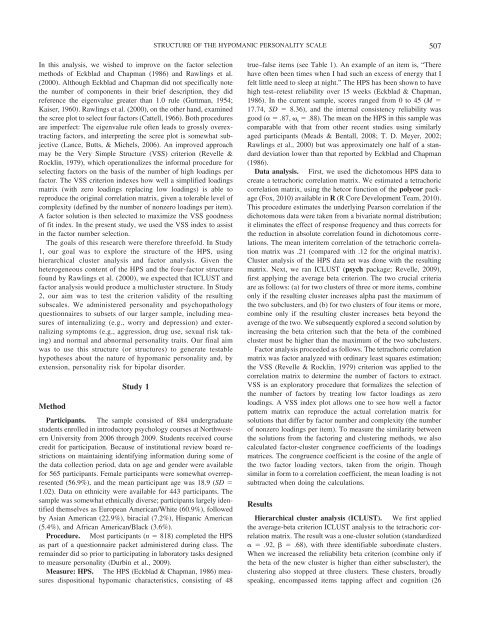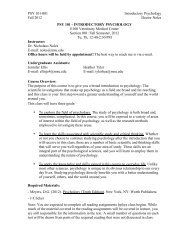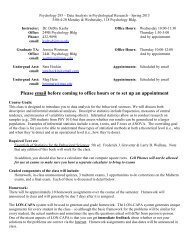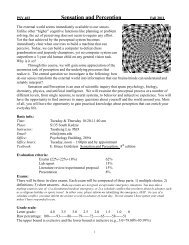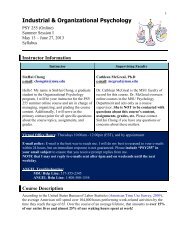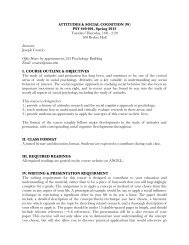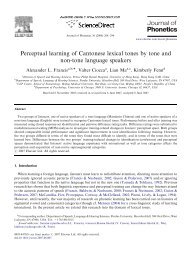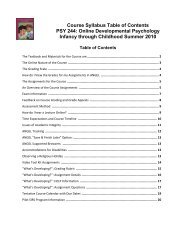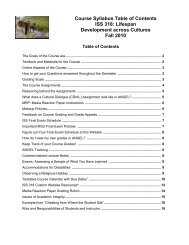STRUCTURE OF THE HYPOMANIC PERSONALITY SCALE507In this analysis, we wished to improve on <strong>the</strong> factor selectionmethods <strong>of</strong> Eckblad and Chapman (1986) and Rawlings et al.(2000). Although Eckblad and Chapman did not specifically note<strong>the</strong> number <strong>of</strong> components in <strong>the</strong>ir brief description, <strong>the</strong>y didreference <strong>the</strong> eigenvalue greater than 1.0 rule (Guttman, 1954;Kaiser, 1960). Rawlings et al. (2000), on <strong>the</strong> o<strong>the</strong>r hand, examined<strong>the</strong> scree plot to select four factors (Cattell, 1966). Both proceduresare imperfect: The eigenvalue rule <strong>of</strong>ten leads to grossly overextractingfactors, and interpreting <strong>the</strong> scree plot is somewhat subjective(Lance, Butts, & Michels, 2006). An improved approachmay be <strong>the</strong> Very Simple <strong>Structure</strong> (VSS) criterion (Revelle &Rocklin, 1979), which operationalizes <strong>the</strong> informal procedure forselecting factors on <strong>the</strong> basis <strong>of</strong> <strong>the</strong> number <strong>of</strong> high loadings perfactor. The VSS criterion indexes how well a simplified loadingsmatrix (with zero loadings replacing low loadings) is able toreproduce <strong>the</strong> original correlation matrix, given a tolerable level <strong>of</strong>complexity (defined by <strong>the</strong> number <strong>of</strong> nonzero loadings per item).A factor solution is <strong>the</strong>n selected to maximize <strong>the</strong> VSS goodness<strong>of</strong> fit index. In <strong>the</strong> present study, we used <strong>the</strong> VSS index to assistin <strong>the</strong> factor number selection.The goals <strong>of</strong> this research were <strong>the</strong>refore threefold. In Study1, our goal was to explore <strong>the</strong> structure <strong>of</strong> <strong>the</strong> HPS, usinghierarchical cluster analysis and factor analysis. Given <strong>the</strong>heterogeneous content <strong>of</strong> <strong>the</strong> HPS and <strong>the</strong> four-factor structurefound by Rawlings et al. (2000), we expected that ICLUST andfactor analysis would produce a multicluster structure. In Study2, our aim was to test <strong>the</strong> criterion validity <strong>of</strong> <strong>the</strong> resultingsubscales. We administered personality and psychopathologyquestionnaires to subsets <strong>of</strong> our larger sample, including measures<strong>of</strong> internalizing (e.g., worry and depression) and externalizingsymptoms (e.g., aggression, drug use, sexual risk taking)and normal and abnormal personality traits. Our final aimwas to use this structure (or structures) to generate testablehypo<strong>the</strong>ses about <strong>the</strong> nature <strong>of</strong> hypomanic personality and, byextension, personality risk for bipolar disorder.Study 1MethodParticipants. The sample consisted <strong>of</strong> 884 undergraduatestudents enrolled in introductory psychology courses at NorthwesternUniversity from 2006 through 2009. Students received coursecredit for participation. Because <strong>of</strong> institutional review board restrictionson maintaining identifying information during some <strong>of</strong><strong>the</strong> data collection period, data on age and gender were availablefor 565 participants. Female participants were somewhat overrepresented(56.9%), and <strong>the</strong> mean participant age was 18.9 (SD 1.02). Data on ethnicity were available for 443 participants. Thesample was somewhat ethnically diverse; participants largely identified<strong>the</strong>mselves as European American/White (60.9%), followedby Asian American (22.9%), biracial (7.2%), Hispanic American(5.4%), and African American/Black (3.6%).Procedure. Most participants (n 818) completed <strong>the</strong> HPSas part <strong>of</strong> a questionnaire packet administered during class. Theremainder did so prior to participating in laboratory tasks designedto measure personality (Durbin et al., 2009).Measure: HPS. The HPS (Eckblad & Chapman, 1986) measuresdispositional hypomanic characteristics, consisting <strong>of</strong> 48true–false items (see Table 1). An example <strong>of</strong> an item is, “Therehave <strong>of</strong>ten been times when I had such an excess <strong>of</strong> energy that Ifelt little need to sleep at night.” The HPS has been shown to havehigh test–retest reliability over 15 weeks (Eckblad & Chapman,1986). In <strong>the</strong> current sample, scores ranged from 0 to 45 (M 17.74, SD 8.36), and <strong>the</strong> internal consistency reliability wasgood (.87, t .88). The mean on <strong>the</strong> HPS in this sample wascomparable with that from o<strong>the</strong>r recent studies using similarlyaged participants (Meads & Bentall, 2008; T. D. Meyer, 2002;Rawlings et al., 2000) but was approximately one half <strong>of</strong> a standarddeviation lower than that reported by Eckblad and Chapman(1986).Data analysis. First, we used <strong>the</strong> dichotomous HPS data tocreate a tetrachoric correlation matrix. We estimated a tetrachoriccorrelation matrix, using <strong>the</strong> hetcor function <strong>of</strong> <strong>the</strong> polycor package(Fox, 2010) available in R (R Core Development Team, 2010).This procedure estimates <strong>the</strong> underlying Pearson correlation if <strong>the</strong>dichotomous data were taken from a bivariate normal distribution;it eliminates <strong>the</strong> effect <strong>of</strong> response frequency and thus corrects for<strong>the</strong> reduction in absolute correlation found in dichotomous correlations.The mean interitem correlation <strong>of</strong> <strong>the</strong> tetrachoric correlationmatrix was .21 (compared with .12 for <strong>the</strong> original matrix).Cluster analysis <strong>of</strong> <strong>the</strong> HPS data set was done with <strong>the</strong> resultingmatrix. Next, we ran ICLUST (psych package; Revelle, 2009),first applying <strong>the</strong> average beta criterion. The two crucial criteriaare as follows: (a) for two clusters <strong>of</strong> three or more items, combineonly if <strong>the</strong> resulting cluster increases alpha past <strong>the</strong> maximum <strong>of</strong><strong>the</strong> two subclusters, and (b) for two clusters <strong>of</strong> four items or more,combine only if <strong>the</strong> resulting cluster increases beta beyond <strong>the</strong>average <strong>of</strong> <strong>the</strong> two. We subsequently explored a second solution byincreasing <strong>the</strong> beta criterion such that <strong>the</strong> beta <strong>of</strong> <strong>the</strong> combinedcluster must be higher than <strong>the</strong> maximum <strong>of</strong> <strong>the</strong> two subclusters.Factor analysis proceeded as follows. The tetrachoric correlationmatrix was factor analyzed with ordinary least squares estimation;<strong>the</strong> VSS (Revelle & Rocklin, 1979) criterion was applied to <strong>the</strong>correlation matrix to determine <strong>the</strong> number <strong>of</strong> factors to extract.VSS is an exploratory procedure that formalizes <strong>the</strong> selection <strong>of</strong><strong>the</strong> number <strong>of</strong> factors by treating low factor loadings as zeroloadings. A VSS index plot allows one to see how well a factorpattern matrix can reproduce <strong>the</strong> actual correlation matrix forsolutions that differ by factor number and complexity (<strong>the</strong> number<strong>of</strong> nonzero loadings per item). To measure <strong>the</strong> similarity between<strong>the</strong> solutions from <strong>the</strong> factoring and clustering methods, we alsocalculated factor-cluster congruence coefficients <strong>of</strong> <strong>the</strong> loadingsmatrices. The congruence coefficient is <strong>the</strong> cosine <strong>of</strong> <strong>the</strong> angle <strong>of</strong><strong>the</strong> two factor loading vectors, taken from <strong>the</strong> origin. Thoughsimilar in form to a correlation coefficient, <strong>the</strong> mean loading is notsubtracted when doing <strong>the</strong> calculations.ResultsHierarchical cluster analysis (ICLUST). We first applied<strong>the</strong> average-beta criterion ICLUST analysis to <strong>the</strong> tetrachoric correlationmatrix. The result was a one-cluster solution (standardized.92, .68), with three identifiable subordinate clusters.When we increased <strong>the</strong> reliability beta criterion (combine only if<strong>the</strong> beta <strong>of</strong> <strong>the</strong> new cluster is higher than ei<strong>the</strong>r subscluster), <strong>the</strong>clustering also stopped at three clusters. These clusters, broadlyspeaking, encompassed items tapping affect and cognition (26
508 SCHALET, DURBIN, AND REVELLEitems), social potency/sociability (13 items), and considering oneselfto be average (9 items).Before we finalized our cluster solution, we inspected <strong>the</strong> graphicaloutput to detect poor fitting items, marked by steep reductionsin beta as items/small subclusters are added to larger subclusters.Four items on <strong>the</strong> affect/cognition cluster (Items 12, 15, 24, and28) resulted in a noticeable drop in beta. Before deciding to deleteany <strong>of</strong> <strong>the</strong>se items, we examined how beta changed with <strong>the</strong>addition <strong>of</strong> each single item to <strong>the</strong> 22-item affect cluster. With<strong>the</strong> addition <strong>of</strong> Items 12, 24, and 28, beta changed from .70 to quitelow levels (.48, .43, and .50, respectively). The addition <strong>of</strong> Item15, however, left beta virtually unchanged at .69. Given that ourprimary purpose was to determine unidimensional clusters, wedropped Item 12 (“I sometimes have felt that nothing can happento me until I do what I am meant to do in life”), Item 24 (“WhenI feel very excited and happy, I almost always know <strong>the</strong> reasonwhy”), and Item 28 (“I frequently write down <strong>the</strong> thoughts andinsights that come to me when I am thinking especially creatively”),but we retained Item 15 to create a 45-item version <strong>of</strong> <strong>the</strong>HPS. Finally, it should be noted that <strong>the</strong> higher beta <strong>of</strong> <strong>the</strong> 45-itemHPS (.66) compared with <strong>the</strong> 48-item HPS (.54) substantiallychanges <strong>the</strong> estimate <strong>of</strong> test variance explained by <strong>the</strong> generalfactor (44% vs. 25%).Applying <strong>the</strong> maximum-beta criterion in ICLUST to <strong>the</strong> 45-itemHPS, a three-cluster solution emerged. Table 1 shows <strong>the</strong> structurematrix <strong>of</strong> this solution and Figure 1 shows <strong>the</strong> hierarchical cluster–subcluster relationships. 1 According to <strong>the</strong> highest loading items,<strong>the</strong> three clusters seemed clearly distinguished by <strong>the</strong>ir content,with <strong>the</strong> first cluster—labeled Mood Volatility (tapping negativeand unpredictable mood states and hypomanic cognition), Excitement(energetic and highly cheerful mood), and Social Vitality(social potency and vivaciousness). The Excitement and MoodVolatility clusters showed <strong>the</strong> highest intercorrelation (r .52,p .05); <strong>the</strong> Social Vitality cluster correlated moderately withboth <strong>the</strong> Excitement (r .42, p .05) and <strong>the</strong> Mood Volatilitycluster (r .35, p .05). 2 All items in <strong>the</strong> clusters were subsequentlyincluded in <strong>the</strong> corresponding subscales, regardless <strong>of</strong> <strong>the</strong>irloading size.Factor analysis. We started our analysis with <strong>the</strong> VSS procedure,using <strong>the</strong> full 48-item tetrachoric correlation matrix. Weapplied VSS with a variety <strong>of</strong> factoring methods (ordinary leastsquares, maximum-likelihood, principal axis, generalized leastsquares) and rotations (promax and oblimin). The VSS indexpeaked most frequently at two-factor solutions at a reasonablelevel <strong>of</strong> complexity (allowing one or two nonzero loadings peritem). Increasing <strong>the</strong> level <strong>of</strong> complexity, <strong>the</strong> VSS index alsopeaked at three factors. We decided to examine <strong>the</strong> two- andthree-factor structures.The eigenvalues <strong>of</strong> <strong>the</strong> first two factors <strong>of</strong> <strong>the</strong> ordinary leastsquares analysis were 11.1 and 4.3, explaining 22% <strong>of</strong> <strong>the</strong> commonvariance. In <strong>the</strong> three-factor solution, <strong>the</strong> eigenvalue <strong>of</strong> <strong>the</strong> thirdfactor was 2.7, with <strong>the</strong> three factors explaining 31% <strong>of</strong> <strong>the</strong>variance. These values contrast with <strong>the</strong> smaller eigenvalues <strong>of</strong>Rawlings et al.’s (2000) largest sample, which were 9.1, 2.7, and2.2; our larger values are likely due to <strong>the</strong> use <strong>of</strong> tetrachoriccorrelations. The second and third factors correlated modestly, r .33, with both factors reflecting emotional content (mood volatilityand excitement). The first factor, reflecting mostly negativelyscored extraversion items, correlated negatively with <strong>the</strong> factorstapping mood volatility (r .32) and excitement (r .17).The pattern matrix is shown in Table 2.To test for similarity among <strong>the</strong> factor and cluster solutions, wecalculated <strong>the</strong> factor–cluster congruence coefficients. This requiredus first to repeat <strong>the</strong> factor analyses on <strong>the</strong> 45-item scales.As shown in Table 2, <strong>the</strong> reduction to 45 items appears justified,given that <strong>the</strong> three items that we eliminated in <strong>the</strong> cluster analyses(Items 12, 24, and 28) also show <strong>the</strong> lowest loadings on any singlefactor as well as <strong>the</strong> lowest communality estimates. First, wecompared <strong>the</strong> two-factor and two-cluster solutions. The twoclustersolution is easily derived from <strong>the</strong> three-cluster solution:Relaxing <strong>the</strong> beta criterion, <strong>the</strong> two emotional clusters (MoodVolatility and Excitement) combine into one, whereas <strong>the</strong> SocialVitality cluster remains intact. Factor–cluster congruence wasnearly perfect for <strong>the</strong> two-group solutions (.99 and .98); consequently,subscales derived from <strong>the</strong> loadings <strong>of</strong> ei<strong>the</strong>r method wereidentical. Factor–cluster congruence for three-group solutions wasalso high (.99, .95, .91), reflecting only a single item (18) thatwould be assigned to a different subscale (to <strong>the</strong> Social Vitalitysubscale instead <strong>of</strong> <strong>the</strong> Excitement subscale) with factor analysis.Given <strong>the</strong> similarity between <strong>the</strong> factor and cluster methods and<strong>the</strong> <strong>the</strong>oretical coherence <strong>of</strong> <strong>the</strong> three-cluster solution, we selected<strong>the</strong> three-cluster solution for fur<strong>the</strong>r reliability and validity analysis.Comparison with <strong>the</strong> factor structure <strong>of</strong> Rawlings et al.(2000). Although Rawlings et al. (2000) reported on factoranalyses <strong>of</strong> three samples, <strong>the</strong>ir British sample was by far <strong>the</strong>largest (N 1,073); accordingly, we compare <strong>the</strong> four-factorpattern matrix <strong>of</strong> <strong>the</strong> British sample to ours. Importing this patternmatrix and repeating <strong>the</strong>ir analytic procedure (maximumlikelihoodfactor analysis, promax rotation, selection <strong>of</strong> four factors)on our dichotomous data, we found that factor congruencebetween <strong>the</strong> results <strong>of</strong> <strong>the</strong> two studies was low (.78, .82, .52, .52).To better understand how <strong>the</strong> results <strong>of</strong> <strong>the</strong> two studies weredifferent, we mapped <strong>the</strong> factor assignments (based on <strong>the</strong> highestloading) onto our cluster solutions. In assigning items to factorsextracted by Rawlings et al., we left out three <strong>of</strong> <strong>the</strong> lowest loadingitems (Items 7, 30, and 39). The first factor (Items 8, 10, 11, 15, 17,1 Figure 1 shows <strong>the</strong> solution for <strong>the</strong> maximum-beta criterion ICLUSTprior to purification, which is slightly discrepant with <strong>the</strong> purified solutionpresented in Table 1. That is, to optimize ICLUST solutions, reshuffling afew items between clusters is sometimes necessary, based on any possiblediscrepant cluster–item correlations. Item 46 (“I <strong>of</strong>ten get into excitedmoods where it’s almost impossible for me to stop talking”) was movedfrom <strong>the</strong> Cluster 40 (Mood Volatility) to Cluster 35 (Excitement), and Item22 (“I very frequently get into moods where I wish I could be everywhereand do everything at once”) was moved from Cluster 42 (Social Vitality)to Cluster 40 (Mood Volatility). Figure 1 also shows that a four-clustersolution is defensible. In this structure, <strong>the</strong> Social Vitality cluster (Cluster42) would be split into a Sociability/Exhibitionism cluster (Cluster 38) anda Surgency/Achievement cluster (Cluster 41). The reliability estimates forCluster 38 were quite high ( .68, h .74, on tetrachoric correlations)but were lower for Cluster 41 ( .58, h .51, on tetrachoric correlations).Space limitations precluded us from describing validity correlationsfor this solution.2 These correlations are based on <strong>the</strong> dichotomous data. Cluster correlationsbased on <strong>the</strong> tetrachoric matrix were slightly higher for each (.61,.49, .39).
- Page 1 and 2: Psychological Assessment© 2011 Ame
- Page 3: 506 SCHALET, DURBIN, AND REVELLETab
- Page 7 and 8: 510 SCHALET, DURBIN, AND REVELLETab
- Page 9 and 10: 512 SCHALET, DURBIN, AND REVELLETat
- Page 11 and 12: 514 SCHALET, DURBIN, AND REVELLETab
- Page 13 and 14: 516 SCHALET, DURBIN, AND REVELLEp
- Page 15 and 16: 518 SCHALET, DURBIN, AND REVELLESoc
- Page 17 and 18: 520 SCHALET, DURBIN, AND REVELLECli
- Page 19: 522 SCHALET, DURBIN, AND REVELLEApp


